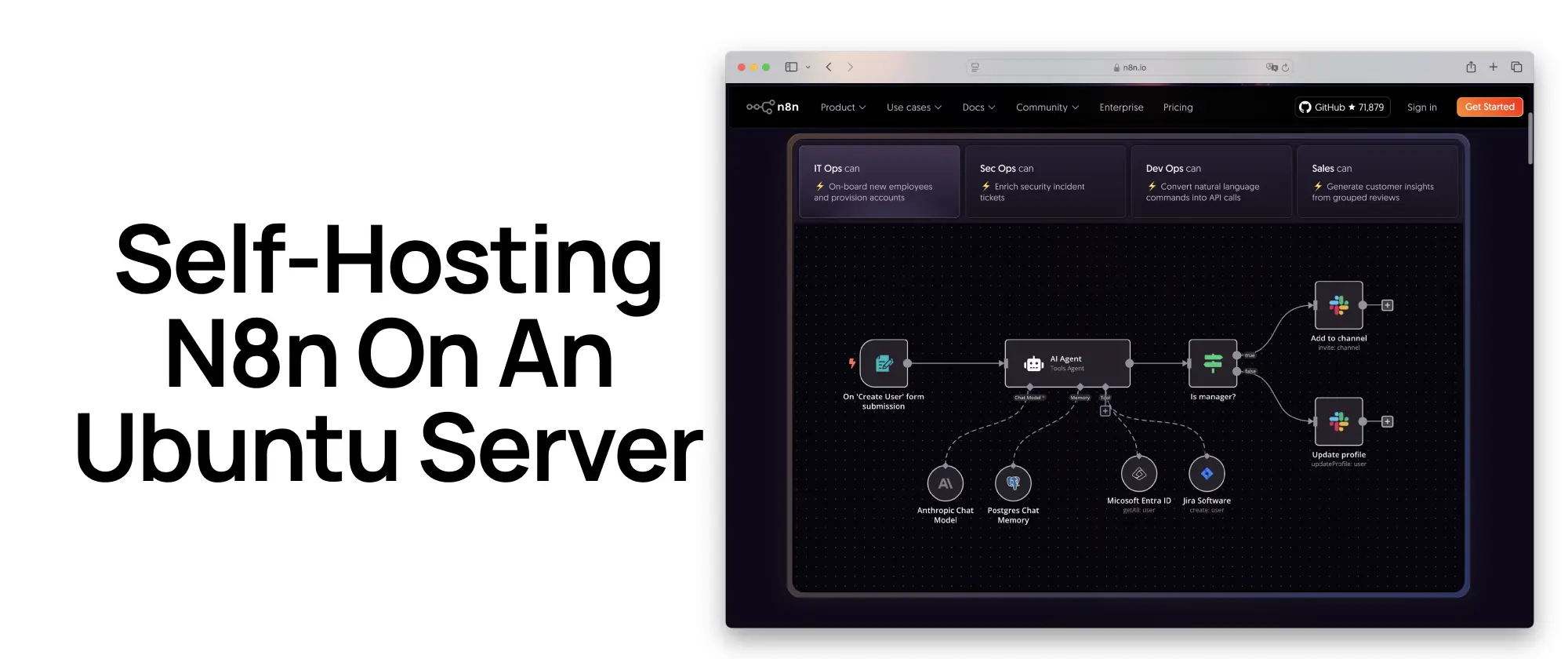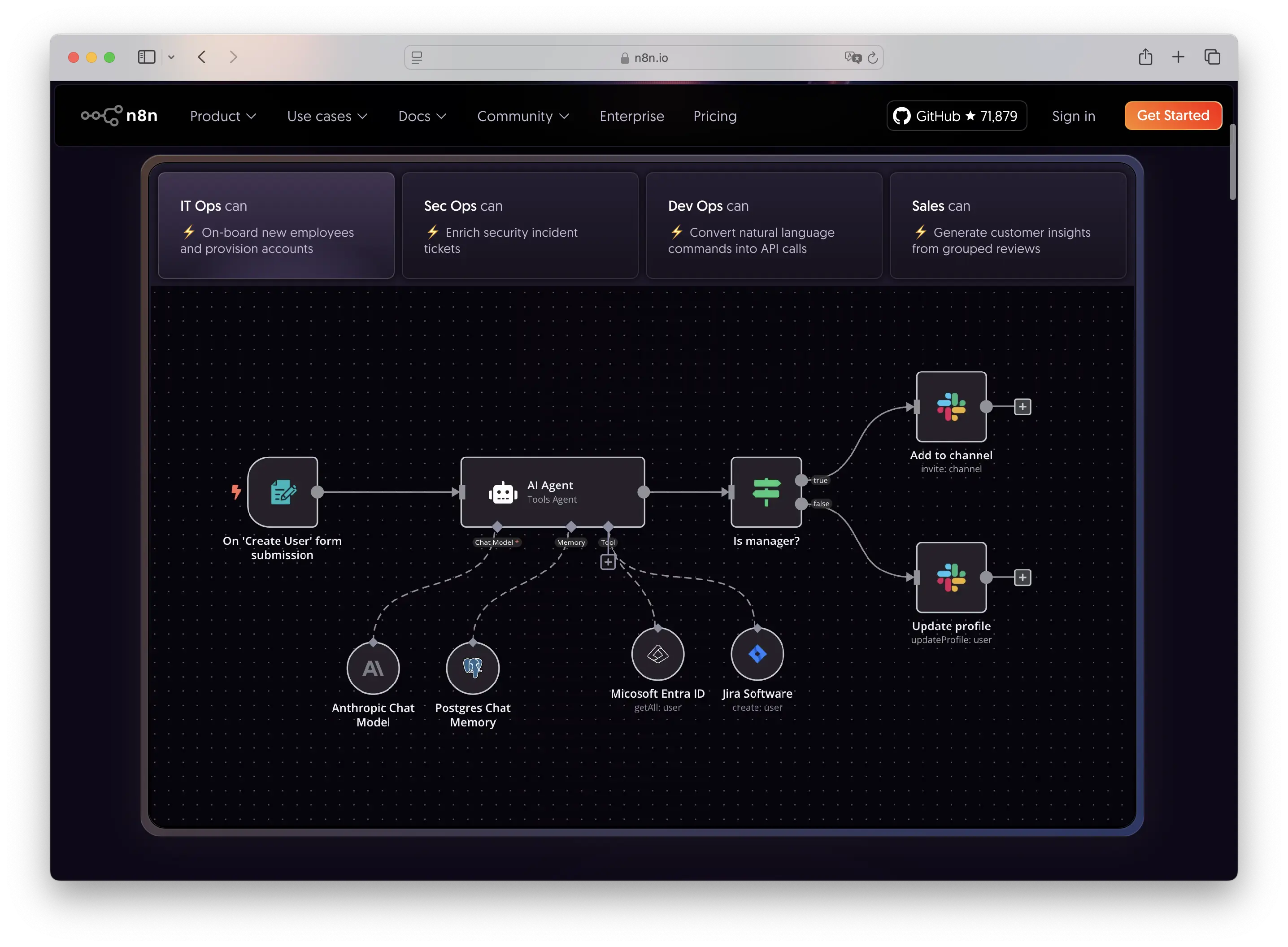
Self-hosting n8n on an Ubuntu Server
 Jonas Scholz
Jonas ScholzWant to automate tasks using n8n but prefer to fully control your infrastructure? By self-hosting n8n on a Linux Ubuntu server, you can cut down costs and manage your data yourself!
Looking for something simpler? If you'd rather skip server management and deploy n8n in just 45 seconds for €9/month, check out our guide on self-hosting n8n the easy way using Sliplane.
Follow along this easy-to-understand guide to learn how you can deploy your own n8n instance using Docker and Caddy Web server for automatic HTTPS.
Before we start, make sure you have:
- a running Ubuntu Linux server instance. A good option is Hetzner, but any Ubuntu server that you can login to with SSH and that has a public IP address works.
- basic SSH experience.
Step 1: Update Your Server
Log into your Ubuntu server via SSH and update the system to ensure it has the latest security patches and updates.
sudo apt-get update
sudo apt-get upgrade -y
Once finished, your server is ready for installing the software.
Step 2: Install and Configure UFW Firewall
Only keep necessary ports open: SSH (22), HTTP (80), HTTPS (443).
Install UFW and configure the firewall as follows:
sudo apt install ufw -y
sudo ufw allow 22 # SSH
sudo ufw allow 80 # HTTP
sudo ufw allow 443 # HTTPS
sudo ufw enable
Check your firewall configuration:
sudo ufw status verbose
Note: Docker can sometimes ignore UFW rules. To tackle this, verify extra settings as explained here.
Step 3: Docker Installation
Docker will be the container system running n8n. Install Docker by running these commands:
Setup dependencies and Docker's GPG key:
sudo apt-get update
sudo apt-get install ca-certificates curl gnupg
sudo install -m 0755 -d /etc/apt/keyrings
curl -fsSL https://download.docker.com/linux/ubuntu/gpg \
| sudo gpg --dearmor -o /etc/apt/keyrings/docker.gpg
sudo chmod a+r /etc/apt/keyrings/docker.gpg
Add Docker repository:
echo \
"deb [arch=$(dpkg --print-architecture) \
signed-by=/etc/apt/keyrings/docker.gpg] \
https://download.docker.com/linux/ubuntu \
$(. /etc/os-release && echo $VERSION_CODENAME) stable" \
| sudo tee /etc/apt/sources.list.d/docker.list > /dev/null
sudo apt-get update
Install Docker Engine and compose-plugin:
sudo apt-get install docker-ce docker-ce-cli \
containerd.io docker-buildx-plugin docker-compose-plugin -y
Check installation:
sudo docker run hello-world
If you see the "hello-world" message, Docker is ready.
Step 4: Installing Caddy for Automatic HTTPS
Caddy simplifies HTTPS configuration since it handles SSL certificates automatically from Let's Encrypt.
Install Caddy:
sudo apt install -y debian-keyring debian-archive-keyring apt-transport-https curl
curl -1sLf 'https://dl.cloudsmith.io/public/caddy/stable/gpg.key' \
| sudo gpg --dearmor -o /usr/share/keyrings/caddy-stable-archive-keyring.gpg
curl -1sLf 'https://dl.cloudsmith.io/public/caddy/stable/debian.deb.txt' \
| sudo tee /etc/apt/sources.list.d/caddy-stable.list
sudo apt update
sudo apt install caddy -y
Edit the Caddyfile configuration file:
sudo nano /etc/caddy/Caddyfile
Enter your domain and configure reverse proxy. Replace "yourdomain.com" with your actual domain name:
yourdomain.com {
reverse_proxy localhost:5678
}
If no domain yet, use this temporarily:
:80 {
reverse_proxy localhost:5678
}
Restart Caddy to load the config:
sudo systemctl restart caddy
Step 5: Running n8n with Docker Compose
We're going to use Docker Compose for easier setup. First create a directory for n8n and navigate to it:
mkdir ~/n8n
cd ~/n8n
Create docker-compose.yml with the following content:
services:
n8n:
image: docker.io/n8nio/n8n:latest
restart: always
ports:
- "5678:5678"
volumes:
- n8n_data:/home/node/.n8n
volumes:
n8n_data:
Now deploy n8n by running Docker compose:
sudo docker compose up -d
Docker pulls the n8n image and runs it in background mode using port 5678.
Step 6: Accessing Your Self-Hosted n8n Instance
Visit your domain in any web browser. Your n8n instance should now load successfully at https://yourdomain.com. Follow the setup steps in the interface to complete your initial setup.

Security Recommendations
Public servers should always be secure. The following practises are recommended:
- Regularly apply updates and security patches.
- Set strong passwords and control user access.
- Monitor server logs for suspicious activity.
- Install tools like Fail2ban for extra security.
Updating your n8n Installation
When you want to update your n8n instance, simply run:
sudo docker compose pull
sudo docker compose up -d
Docker will download updated versions automatically and replace your current containers.
Cost Comparison with Other Providers
Self-hosting n8n typically results in lower cost compared to hosted services:
| Provider | vCPU | RAM | Disk | Monthly Cost |
|---|---|---|---|---|
| Render.com | 1 | 2 GB | 40 GB | ~$35 |
| Fly.io | 2 | 2 GB | 40 GB | ~$17–20 |
| Railway | 2 | 2 GB | 40 GB | ~$15–30 |
| Sliplane.io | 2 | 2 GB | 40 GB | ~€9.50 flat |
| Hetzner Cloud (self-hosted) | 2 | 2 GB | 40 GB | ~€5–10 € / month |
You maintain complete control and avoid additional usage-based charges by self-hosting. But of course there is no free lunch and you're now responsible for managing your own server!
Is anything missing with a self-hosted n8n?
Self-hosted n8n (community edition) misses some features included in the official hosted version, but generally provides everything you need. You can check the complete differences on the n8n website.
Now you have your own self-hosted n8n instance running on Ubuntu! Time to start automating your workflows.
If managing and securing your own server is a bit too much for you, check out how easy it is to deploy a managed instance of n8n on sliplane (takes 45 seconds!)